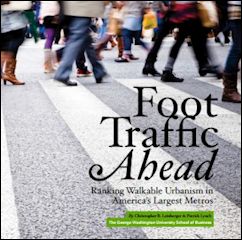The Washington metropolitan region is the national model for “walkable urbanism” in the United States — more so even than metropolitan New York, according to the findings of “Foot Traffic Ahead: Ranking Walkable Urbanism in America’s Largest Metros,” a report released this morning by LOCUS, an organization of smart-growth real estate developers, and Smart Growth America.
The study identified 558 WalkUPs — regionally significant activity centers characterized by a high level of walkability — in the nation’s 30 largest metros. Forty-five of them are located in the Washington region, about half in the District of Columbia and half in surrounding Virginia and Maryland jurisdictions. The overall walkability exceeds even that of New York. While Manhattan is the single-most walkable place in the United States, it accounts for only 0.3% of the New York metro region’s land mass, and outer jurisdictions dilute its overall walkability, explained Christopher B. Leinberger, LOCUS president and co-author of the report, during the LOCUS annual conference.
Washington’s lead in developing “walkable urbanism,” in contrast to the “drivable suburbanism” that dominated U.S. growth and development between World War II and the Great Recession of 2007-2008, should stand the region in good stead as it faces an economic future made insecure by the retrenchment of its main growth industry, the federal government. Walkable urbanism is closely correlated with the presence of a highly educated workforce, and a highly educated workforce is closely correlated with faster economic growth. While correlation does not necessarily mean causality, an argument can be made the the desirable attributes of walkable urbanism make it easier to attract and retain educated workers who, in turn, contribute to economic growth.
The report findings suggest that there will be future demand for hundreds of millions of square feet of walkable development over the next generation, said Leinberger. “This is likely the end of sprawl.”
A clear sign of shifting market preference is the 74% premium the market is willing to pay for office space in WalkUPs compared to space in Drivable Urbanism. That’s the reverse of 30 years ago when suburban office parks enjoyed a marked advantage, Leinberger said. Even excluding the New York market, which skews the results, WalkUps enjoy a 44% edge, he said.
While Washington was the star metro, some surprising regions have been coming on strong thanks to dramatic shifts in development patterns in the post-2008 development cycle. Metropolitan Atlanta, which only 20 years ago was the poster child of sprawl, has concentrated 50% of its development in WalkUP districts comprising only 1% of the region’s land mass. Perhaps even more surprisingly, Detroit has seen similarly focused re-development in downtown, midtown and a handful of urbanizing suburbs.
Leinberger attributed Washington region’s success to five main factors. First, the region has the highest overall education level of any metro in the country, Second, the region has been aggressively expanded its Metro rail system; 80% of the WalkUPs in the region are, or soon will be, served by Metro. Third, for the most part local governments put in the right kind of zoning around their Metro stations, encouraging walkable, mixed-use development. Fourth, the region’s real estate industry has mastered the discipline of developing WalkUPs, which are inherently more complex and expensive than green-field development. And fifth, the public sector has done an exceptionally good job of “place management” — creating quality walkable places.
While rail transit gives a big boost to walkable urbanism, said Leinberger, it is not essential. One out of five WalkUPs in the Washington region are not connected to the Metro. Also, many small cities and towns have walkable places. “It sure does help but it is not required.”
Emerick Corsi, president of Forest City Enterprises Real Estate, agreed. “Walkable can be built anywhere,” he said. He cited the example of a town miles outside of Los Angeles where his firm is converting an old shopping center into 2 million square feet of new buildings with the capability to expand a lot more by going “totally vertical.” There is no transit but the development will be highly walkable, he said.
Leinberger predicted that real estate development in the foreseeable future will be driven by the desire to meet the demand for walkable urbanism. The process won’t necessarily be smooth. Some metros — San Antonio, Kansas City, San Diego — have continued to sprawl. Providing affordable housing in the most desirable areas will be a challenge. But if Leinberger is right and the most walkable regions prove to be the most economically dynamic regions, the success of metros like Washington, Boston, New York and even Atlanta and Detroit will be clear for all to see.



